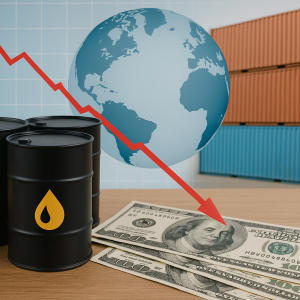Share on
- La America First Trade Policy of the second Trump administration promises to be more aggressive and unpredictable than the approach taken in the first term and threatens a protectionist escalation that could reshape the geography of world trade.
- On 1 February 2025, the new US president announced additional tariffs of 25% on imports from Canada and Mexico, which were introduced on 3 February and suspended the next day for one month, and 10% on imports from China, which took effect immediately, and the reintroduction of tariffs at 25% on all foreign purchases of steel and aluminium, which were suspended for a group of 'friendly' countries, including the EU (from 2021). The affected countries announced tariff countermeasures on US goods.
- Goals and instruments of US policies go beyond the commercial sphere to include national security and geopolitical issues: reducing foreign dependence, defending industry, strengthening leadership in new technologies.
- Selective duties per country and/or product are a tool for: negotiating different objectives, such as border control (escalate to de-escalate); reduce the bargaining strength of counterparts (divide and rule); contain China's technological trajectory (decoupling).
- Tariffs are a tax, paid by importers, that is passed on to US households and businesses. The final impact is a (one-off) increase in consumer prices. The extent of the transmission depends on the pricing policies of exporters (who can lower their prices) and domestic producers (whose margins can absorb part of the cost increase) and on exchange rate adjustments (which anticipate the duties and can offset them). Empirical work based on the experience of the first Trump administration shows that duties were passed on entirely in purchase prices (with exceptions, e.g. in steel), with a final impact of lower margins for firms and higher prices for consumers.
- The duties do not significantly affect the trade deficit and have a negative impact on the GDP of the country imposing them: about -0.2% estimated following the Trump I duties (2018-2019). The impact is amplified in the long run, as less international competition and the survival of less efficient firms reduce potential economic growth.
- In terms of political consensus, tariffs are perceived positively among the sectors and territories most exposed to global market integration, international competition and competition from producers considered to be rivals, especially those accused of adopting illicit and/or unfair trade practices, such as China.
- Vietnam in the case of China and Mexico in the case of the US); to the generalised digression of trade (goods that no longer find access to the US market seek other destinations); to the relocation of certain strategic supply chains to the US (e.g. metals); to the overall drying up of industrial collaborations, including those devoted to research and innovation.
- Given the heterogeneity and asynchrony of these effects, the overall impact is, therefore, difficult to estimate. It depends on many variables: the distribution of duties per country/product, the rate and duration of duties, the price elasticity of demand for products, the reaction of the exchange rate, the exposure of trading partners to duties. For Italy and Europe, considerable risks are foreshadowed, alongside, however, some opportunities, in terms of potentially contestable market shares in the US market freed up by the decoupling with China.
- Nevertheless, these variables fuel uncertainty, which holds back trade in goods, services and productive capital. According to previous analyses by Centro Studi Confindustria, a persistent 10% increase in global uncertainty about economic policy is associated with a lower growth (in the following quarter) of almost half a percentage point in world trade, as a result of both a slowdown in industrial activity and lower trade intensity.
- In the case of Italy, the economic connections are extremely deep. The US is the number one non-EU destination for Italian exports of goods and services and the number one destination for foreign direct investment.
- In 2024, sales of Italian goods to the US amounted to approximately EUR 65 billion, generating a surplus close to EUR 39 billion. Despite a decline in the last year, the US market made the highest contribution to Italian export growth since pre-Covid.
- Italy's direct investments in the US amount to almost 5 billion per year, 27% of the total (average 2022-2023); 1.5 billion per year flows from the US to Italy. The net outflow of capital is a sign of the dynamism of Italian multinationals (also thanks to US incentives), but also of the limited attractiveness of the Italian market for American capital.
- American multinationals on Italian territory, however, are the first in terms of number of employees (more than 350,000 in 2022), contributing more than a fifth to national added value and research and development spending. The presence of US multinationals is particularly important in Italian manufacturing, where more than 110 thousand people are concentrated. In the electronics and ICT sector, 90% of non-EU multinationals are US-owned.
- Almost all Italian manufacturing sectors enjoy a trade surplus with the US. Machinery and equipment (leading exporting sector), pharmaceuticals (leading importing sector, despite a surplus of almost double the value), motor vehicles and other transport equipment, food and other manufacturing goods together generate almost three quarters of Italy's surplus with the US (2023 data).
- The primary sector, on the other hand, recorded a deficit, fuelled mainly by purchases of natural gas, which helped to replace Russian supplies (for almost EUR 7 billion in Italy and EUR 70 billion in Europe in 2023). An increase in gas imports could be part of the transatlantic negotiations, diluting the demands for rebalancing the trade balance.
- Italian exports are more exposed than the EU average to the US market: 22.2% of Italian non-EU sales, compared to 19.7% of EU sales. Among the most exposed sectors are beverages (39%), motor vehicles and other transport equipment (30.7% and 34.0%, respectively) and pharmaceuticals (30.7%).
- Conversely, Italian imports are less dependent than the EU average on US supplies: 9.9% compared to 13.8% for non-EU purchases. The most dependent sectors are pharmaceuticals (38.6%) and beverages (38.3%), which are also dependent on the export side. This highlights the deep integration of these production chains and their high risk in case of duties and retaliation.
- Italy's exposure to the US increases if one also considers indirect production connections, i.e. sales of semi-finished products that are incorporated into products for the US market. According to estimates by the Centro Studi Confindustria, a significant share of total sales (foreign and domestic) of pharmaceuticals (17.4%) and other transport equipment (16.5%) is directly and indirectly activated by the US market. This is followed by motor vehicles, machinery and equipment, other manufacturing, leather and footwear. For total manufacturing, the weight of the US as a destination market is about 7% of sales (5% from direct flows and the remainder from indirect connections).
- Italy and other EU countries export a wide variety of products to the US (80% of all categories sold by Italy worldwide and more than 90% by the EU).
- In order to identify the products most at risk of possible US duties, we have formulated three granular selection criteria, based on: i) export exposure; ii) level of bilateral surplus; iii) strategicity of the products according to the US logic of economic security. Also on the basis of these criteria, Italian exports are more diversified than those of the member countries as a whole. Moreover, American strategic products are more relevant both in terms of variety and value for the average European country.
- The top sectors for all three criteria (exposure, surplus and strategicity), for both Italy and Europe, are chemicals and pharmaceuticals. The strong manufacturing links between the two sides of the Atlantic could be a deterrent to a tariff run-up: more than 70% of the capital stock invested by EU pharmaceutical companies in non-EU countries is directed to the USA; the share is the same for German pharmaceutical multinationals while Italian ones are close to 90%.
- Other Italian products for which the US market is relevant, according to the exposure and surplus criteria, also include transport equipment, machinery and food and beverages: product sectors with a high export propensity, for which US demand has strengthened in recent years, and thus also potentially a negotiating tool for the US administration.
1. US duties: an ever-changing scenario
The second Trump mandate reopens a potentially much broader and deeper trade war scenario than the first, when duties applied and maintained had almost exclusively concerned China, while those aimed at the EU and other countries were limited in terms of rates and/or mitigated by subsequent understandings.
Between 2018 and 2020, in fact, the US introduced duties on two-thirds of imports from China, with an average imposition of 19.3% on total purchases from China (up from just 3.1% at the beginning of 2018), triggering counter-duties of a similar magnitude on the Chinese side (on about 58% of imports from the US, with the average tariff rising from 8.0% to 21.1%).
US tariffs on purchases from the rest of the world, on the other hand, increased marginally, remaining at very low levels (from 2.2% to 3.0% on total non-China imports). These include tariffs of 25% and 10% on US imports of steel and aluminium respectively (suspended for EU exporters by the Biden administration at the end of 2021).
The approach of the second term appears decidedly less inclined to strategic alliances, waivers, or exemptions and strategically leverages the almost daily announcements of new measures also aimed at 'friendly' countries, starting with Canada and Mexico: privileged trade and economic partners to which the US is bound by the USMCA (United States-Mexico-Canada Agreement, formerly NAFTA).
On 1 February 2025, the new US president announced additional tariffs of 25% on all products from Canada and Mexico (reduced to 10% for energy from Canada) and 10% on purchases from China. The motivation refers to national security emergencies: the entry from these countries of drugs, such as fentanyl, and illegal immigration, particularly from the Mexican border.
These measures were suspended the next day for a month before being implemented, following commitments by these countries to tighten controls on irregular border flows and trafficking in drugs and illicit substances. The additional ones on imports from China, on the other hand, took effect on 4 February, provoking a reaction from the Chinese authorities in the form of counter-duties on selected US products and export controls on rare earths.
In addition, Trump reiterated his intention to extend tariff barriers to other countries, including the EU, in the near future. On 10 February, he announced the re-introduction of erga omnes tariffs on steel and aluminium as of 12 March next, cancelling all suspensions and exemptions introduced (in addition to the EU, Argentina, Australia, Brazil, Canada, Mexico, South Korea, Japan UK and Ukraine) and equating the tariffs to 25% on both materials. On some occasions, it also threatened universal tariffs of 10-20% on all US imports.
If all these measures are actually implemented, it is very likely that a real escalation will take place. Canada and Mexico had already announced counter-demands, and the European Commission said it was ready to move in the same direction.
The very high uncertainty generated by the mere threat of plunging trade and economic relations into retaliatory spirals is capable, by itself, of producing profound effects on global trade and economic connections. Particularly exposed to these tensions are the European economies, especially the Italian one, which are very open to foreign trade, integrated in global value chains and closely connected to the US economy.
The following analysis is divided into two parts. In the first, we review the motivations and instruments of US trade policy and its possible economic consequences, in the US and in the pattern of world trade.
In the second part, we analyse the potential direct and indirect transmission channels to the Italian economy, the most exposed sectors and the products potentially most at risk, also based on the policy priorities identified above.
2. What future scenarios? Policy instruments, economic theory and stylised facts
2.1 Objectives and instruments of US trade policies
The national security emergency adopted by Trump to motivate the tariffs on Canada, Mexico and China is one of the trade policy tools at the disposal of the US administration, according to the International Emergency Economic Powers Act.
There are currently four institutional instruments that can be used by the US Administration, with a differentiated procedure depending on the type of 'threats' to be faced (Scheme A). The different legislative institutes grant the President the possibility of imposing tariff barriers in order to protect the US economy in the face of:
- discriminatory conduct by other countries, without the need for prior analysis (Section 338, Tariff Act 1930);
- national security threats aimed at strategic products and supply chains, according to a Department of Commerce report (Section 232, Trade Expansion Act 1962);
- unfair trade conduct and/or excessive trade deficits, subject to analysis by the Department of Commerce (Sections 301 and 122, Trade Act 1974);
- more general threats to the economic and social security of the country, without prior analysis (International Emergency Economic Power Act 1977).
These instruments provide the legal basis for the decisions related to the America First Trade Policy memorandum of 20 January 2025 by combining national security needs, deficit and foreign dependency reduction, and combating practices deemed unfair with the goal of enhancing US industrial and technological advantages globally in the interests of American businesses and workers. The memorandum calls for the submission by 1 April 2025 of analyses and proposals along multiple economic, trade, geopolitical, and strategic dimensions that largely overlap and mutually reinforce each other.

Economic and trade objectives include: rebalancing the trade deficit; increasing tax revenues from tariffs; and favouring domestic enterprises.
The more trade-specific ones include: combating unfair practices of other countries (anti-dumping and countervailing duties, exchange rate manipulation, counterfeit products and smuggled drugs, discriminatory taxes abroad against US citizens and companies); negotiating or renegotiating bilateral and sectoral agreements (including those with Canada and Mexico and with China).
On China, in particular, the geopolitical focus is on unfair and discriminatory practices, circumvention through third countries, and the defence of intellectual property rights (patents, copyrights and trademarks).
These objectives are intertwined and expanded within the strategic dimension of economic security, which includes: a comprehensive review of the security of the industrial and manufacturing base, with a focus on steel and aluminium imports; a strengthening and expansion of export controls (including by increasing foreign compliance) to maintain a technological advantage over strategic adversaries or geopolitical rivals; control of information and communication technologies; strengthening US investment in national security technologies and products in foreign countries of interest; restrictions on foreign financial participation in federal procurement; and combating illegal immigration and the import of fentanyl.
2.2 Negative macroeconomic effects
In the light of the broad spectrum of objectives and instruments available (which do not, therefore, consist solely of the application of tariffs), an estimation of the economic impact of tariff measures alone seems a premature and poorly predictive exercise.
Very useful, however, is to frame and schematise the different potential channels of transmission of the effects of tariffs to the US economy and along international connections, based on two main dimensions: the countries and products affected (see Chart B).

A first effect, as already mentioned, is that of uncertainty itself on the evolution of trade and economic relations between major countries and global governance in general. The index of economic policy uncertainty (Economic Policy Uncertainty), for example, reached a record high of 345 in November, higher than the previous peak reached during the first Trump administration.
This has an immediate dampening effect on the dynamics of world trade: according to previous analyses by Centro Studi Confindustria, a persistent 10% increase in global uncertainty about economic policy is associated with a lower growth (in the following quarter) of almost half a percentage point in world trade, as a result of both a slowdown in industrial activity and lower trade intensity.
As far as the US domestic economy is concerned, economic theory and empirical evidence lead to robust conclusions: tariffs have a negative or insignificant aggregate impact on deficit reduction, without considering the perverse effects of trade retaliation. The main findings are as follows (Diagram B, left-hand side panel).
- The effect of duties on the US trade balance is essentially nil. The duties introduced by the first Trump administration did not favour a return to the US deficit (see Section 1.3). Instead, the balance is determined by savings and investment levels, which depend primarily on macroeconomic factors such as household confidence and consumption, demographics, and fiscal policies.
-
Tariffs reduce the flow of goods in both directions. Directly on the import side, by favouring domestic products. Indirectly on the export side, through an appreciation of the exchange rate and an increase in the cost of imported inputs: factors that reduce the foreign competitiveness of US production. Moreover, imports and exports are correlated, because they may involve different stages of the same production process along global value chains.
-
Tariffs are a tax that is passed on to US households and businesses. The final impact is a (one-off) increase in consumer prices, directly via imported consumer goods and indirectly via business costs. The extent of the transmission depends on the pricing policies of exporters (who can lower their prices) and domestic producers (whose margins can absorb part of the cost increase). Empirical work based on the experience of the first Trump administration shows that the pass-through was complete for most products, i.e. the duties were passed on entirely to purchase prices and production costs in the US (with exceptions, e.g. in steel), with a final impact of lower margins for firms and higher prices for consumers. Between October 2017 and October 2019, the price of US imports from China fell by only 1.4% against a tariff increase on Chinese imports of 25%.
-
The effects on GDP are negative, due to a less efficient use of production factors, and quite small for a large economy with relatively little foreign trade such as the US: about -0.2% estimated following the Trump I tariffs (2018-2019). However, the impact widens in the long run, as less international competition and the survival of less efficient firms reduces potential economic growth.
Economists therefore agree that tariffs are a bad policy instrument. Why then do they not receive general voter opposition?
One answer lies in the fact that the aggregate impact is modest (entirely outweighed by the Covid emergency in 2020) and, above all, diffuse among end consumers, who can also replace the price-increasing products with domestic ones (and from countries not affected by duties, if these are not erga omnes).
Conversely, the favourable impact is limited to domestic production defended by duties, which can also be the subject of policies to incentivise and attract investment from abroad, and therefore immediately appreciable by the workers and companies concerned. These are typically industrial sectors and geographical areas that have been most affected by globalisation and competition, including unfair competition, from China.
2.3 Selective effects by country and product
The deeper reasons for tariff measures thus lie in their selective nature, by country and by product, and in the extreme flexibility of their application. Tariffs, in fact, can be announced and then postponed, revised, accompanied by other non-tariff measures, such as export bans, screening of foreign investments, etc.
This makes them a powerful instrument of economic policy, transcending the sphere of trade, to include issues of foreign investment, technological leadership, control of strategic production nodes, international taxation, and even the military.
However, it is an extremely distorting instrument, artificially producing winners and losers. The effects unfold at a disaggregated level, between countries and between sectors. It is useful to review them schematically.
Country selective duties (Schedule B, top right-hand box):
- Reducing the bilateral deficit. The US tariffs on China of the first Trump administration, confirmed by the Biden administration, as anticipated, did not lead to a containment of the trade deficit, which in 2023 exceeded USD 1 trillion and fluctuated around -4% of GDP, the same levels as before the Trump administration. Instead, there was a rebalancing of bilateral deficits with major trading partners (Chart 1). In particular, the deficit vis-à-vis China has shrunk by more than a third over the past six years, but the deficit vis-à-vis some Asian countries, Vietnam, Taiwan, South Korea and India, has increased sharply. The negative balance vis-à-vis the other main partners, the EU countries, Canada and Mexico, has also widened. Moreover, even in the presence of tariffs, the deficit with China increased in the two-year period following the outbreak of the pandemic (2021-2022), due to the high demand for certain products, such as electric batteries, which is not satisfied by domestic production capacity or alternative suppliers, at least in the short term, i.e. for which it is difficult to reduce dependence on the Asian power.

- Inefficient reconfiguration of trade and production flows and triangulations. The tariffs on China have therefore caused a strong geographical reconfiguration of trade flows, with very heterogeneous characteristics: greater opportunities in the US market for other exporters, including European ones; greater pressure of Chinese overproduction towards other destinations, including European ones; increase in indirect connections between China and the United States, through trade and/or ownership links in other Asian and American countries (e.g. Vietnam and Mexico), to bypass the duties. Bilateral tariffs, therefore, cause distorting effects, which are difficult to monitor and also limit their impact on reducing dependencies.
- Escalate to de-escalate. The imposition or mere announcement of tariffs is a bilateral bargaining tool to achieve other geo-economic goals, even with geopolitically 'friendly' countries: border control with Mexico and Canada, military spending by allies in NATO, taxation of US multinationals in the EU, etc.
-
Divide and rule. The application of differentiated tariffs between countries, potentially also between EU countries, puts the US, the world's leading economic power, in a particularly strong bargaining position. This element, in combination with the different geo-economic objectives listed above, represents a strong criticality for the EU's common trade policy.
Finally, duties can select, in great detail, specific products and sectors, possibly combined with geographical origin (Diagram B, boxes below).
-
Specific erga omnes tariff lines may cover productions that are strategic for national security or at risk of excessive foreign dependence, such as metal supplies (steel and aluminium) and the automotive industry. The universality of tariffs reduces the risk of trade diversion (one of the reasons Trump adopted in February 2025 to eliminate exemptions on steel and aluminium from 'friendly' countries), even though the same rate may have different trade effects on differently specialised economies. Moreover, the measures can be combined with others to stimulate domestic production and attract manufacturing investment from 'friendly' countries, such as those contained in the Inflation Reduction Act. This leads to a potential relocation of production to the disadvantage of the closest and most interconnected partner countries, such as the EU.
-
China to make faster progress on the technological frontier in general and in chip production in particular, reducing dependence on American companies.
-
Strategic rebalancing with friendly countries. A strengthening of integration in strategic supply chains such as energy between the US and its western partners is plausible. US natural gas exports, in particular, could partially rebalance the US-EU trade balance. Conversely, if tensions spread to friendly countries, the effects, including reduced international cooperation in research and innovation, would reduce global growth in the long run.
3. The role of the United States for Italian and European trade and investment
3.1 Multiple and deep economic connections
The economic connections between Italy and the United States, which can be directly and indirectly affected by US trade policies, are deep and very heterogeneous.
In fact, the US is the leading non-EU destination for Italian flows of goods, services and foreign direct investment (Table 1).

Sales of Italian goods to the US amounted to about EUR 65 billion in 2024, more than one-tenth of total exports (10.4%, provisional estimates), despite a decline from a peak of more than 67 in 2023. The US is by far the leading non-EU destination of Italian products and the second largest behind Germany, having overtaken France in 2022.
Italian purchases of US goods reached almost 26 billion in 2024, less than one twentieth of total imports (4.6% estimated). However, this is the second largest market of non-EU origin after China, which in turn is second only to Germany.
As a result, Italy's trade balance with the US was close to EUR 39 billion, contributing a large part of the total trade surplus (around EUR 54 billion).
A more significant role of the US market on the export side than on the import side is confirmed by the dynamics of Italian trade per country from 2019 (pre-Covid peak) to 2023 (see Chart 2).

The increase in sales to the US contributed 4.5 percentage points to the increase in total exports (about 30% cumulated over the period): the highest single contribution of all countries in the world. The contribution of imports from the US, on the other hand, was below 2 percentage points (out of a total of almost 40%): less than those of Germany, China, the Netherlands (hub for non-EU products), France, Spain and even Algeria (gas supplier).
The Italy-US trade in services is more balanced: in 2023 (latest available data) 12.7 billion in sales and 10.1 billion in purchases, with a positive balance of 2.5 billion, which only partially balances the negative balance with the rest of the world (-10.2 billion, excluding the USA); only with Switzerland does Italy have a greater surplus in services.
About half of Italian services exports to the US are inbound tourism and another third professional and information services. These services also generate a substantial portion of the import of services from the US (in particular, Italian tourism in the US); in addition, Italians pay American companies a large portion of the fees for the use of intellectual property.
Finally, an analysis of the exchange of goods and services between the two sides of the Atlantic cannot disregard production-type relations. The presence of multinationals, in fact, fuels a significant share of bilateral trade in goods and services. In particular, for Italy, the share of foreign multinationals' contribution to merchandise exports is 35% while that to imports is close to 50%.
The United States is the top destination of Italian direct investments abroad, even compared to European countries, in the last two-year period for which data are available (2022-2023): almost 5 billion per year, accounting for as much as 27% of the total (average 2022-2023). Just 1.5 billion per year, on the other hand, was invested by US residents in Italy.
There was, therefore, a net outflow of productive capital to the United States. This figure can be read positively, as a sign of the dynamism of Italian multinationals in the United States and of the attractiveness of the US market, also thanks to the incentives for domestic production; a dynamic consistent with the good performance of exports to the USA. Conversely, on the negative side, the Italian market appears relatively unattractive to American capital. This is in line with the relatively subdued dynamics of imports from the USA.
The productive connections that Italy and other EU countries have made over time with the US are evidenced by the stock of foreign direct investment. The US as a foreign investor accounts for almost a third of the stock of capital invested in the EU (by non-EU countries) and as an investment destination for more than a quarter of the total invested by European firms (in non-EU countries, Table 2).
The Italian economy is less exposed than France and Germany, and the average European country, to production links with the United States, both inbound and outbound. However, if one looks at the statistics by ultimate investor and not only as an immediate counterpart, tracing back through corporate ties to actual ownership, the presence of American companies is much more relevant even for Italy, coming to represent more than 30% of the stock of non-EU capital invested in the national economy.

In order to grasp the actual economic relationship that foreign capital invested in their respective economies has created, it is worth considering the statistics on multinationals. In 2022 (the last year of survey available), American multinationals present on Italian territory were the first in terms of number of employees (more than 350,000, table 3), contributing more than a fifth to national added value and research and development spending. The presence of American multinationals is particularly important in Italian manufacturing, where more than 110 thousand employees are concentrated. Going into sectoral detail, 90% of the non-EU multinationals in the electronics and ICT sector are American-owned.
In addition, the United States is the preferred destination for Italian multinationals: in 2022, it ranks first in terms of the number of foreign companies controlled by Italian companies and second, immediately after Brazil, in terms of the number of employees, producing a turnover equal to 14% of that achieved by companies resident in Italy.


3.2 Direct and indirect sectoral exposure to trade with the US
The main Italian manufacturing sectors are potentially exposed to US protectionist measures.
In fact, all sectors enjoy a trade surplus with the US, with the exception of a marginal deficit in paper (2023 data)
The main sectors in terms of exports, imports and balance with the US are machinery and equipment (top exporter), pharmaceuticals (top importer), motor vehicles and other transport equipment, foodstuffs and other manufactured goods. Together, they generate almost three quarters of Italy's trade surplus with the US (Table 4).

The Italian balance contributes a significant part of the total EU countries' balance with the US: around 27% of the total, second only to the German balance (55%).
The European manufacturing sectors contributing most to the trade surplus correspond to those identified for Italy, with the exception of other transport equipment (negative balance at EU level), and with the addition of electrical appliances and base metals.
In the primary sector, on the other hand, Italy and the EU as a whole have a trade deficit with the US, fuelled mainly by purchases of US natural gas, which have helped to replace Russian supplies, reaching a value of just under EUR 7 billion in Italy and almost EUR 70 billion in Europe in 2023. US gas imports could be further increased, also to meet the Trump administration's demands for a rebalancing of the trade balance.
In order to capture the sectoral exposure to the US market, however, it is useful to calculate the weight of flows with the US in total sector flows.
For compatibility at EU level, let us first consider extra-EU trade only. According to this metric, the most exposed Italian sectors are beverages (39% of extra-EU exports to the US), motor vehicles and other transport equipment (30.7% and 34.0%, respectively) and pharmaceuticals (30.7%). These sectors are also more exposed to the US in Italy than the EU average; at lower levels, Italian foodstuffs also stands out. The exception is pharmaceuticals, which is even more exposed to the US at the EU level (34.7%, the highest value; see Chart 3).


Overall, however, Italian exports are more exposed than the EU average to the US destination market: 22.2% compared to 19.7% for extra-EU sales. Conversely, total Italian imports are less dependent than the EU average on US supplies: 9.9% and 13.8%, respectively, of extra-EU purchases.
The most exposed Italian sectors are pharmaceuticals (38.6%) and beverages (38.3%; well above the EU average), whose connections with the US therefore go in both directions, highlighting the deep integration of production chains (see Chart 4). Any protectionist measures would have cascading effects on both flows, with a limited impact on balances.


Among others iftors, the US weight in imports of other transport equipment (excluding motor vehicles) from the US is very high for the EU (42.5%, the highest value), less so for Italy alone (15.0%). Motor vehicles, on the other hand, are not dependent on the purchase side, especially in Italy (just 3.5%), signalling an unbalanced connection on the sales side, and thus potentially more affected by any US tariff barriers.
Finally, the calculation of sectoral exposure, i.e. the weight of flows with the US, can be enriched along two dimensions: at the numerator, by adding to direct flows to the US also indirect flows, i.e. sales of semi-finished products to other sectors, domestic and foreign, that are incorporated into products for the US market; at the denominator, by considering a broader aggregate such as total exports or preferably total sales (including domestic sales).
The direct and indirect connections to the US destination market, as a percentage of total sectoral output, based on estimates by Centro Studi Confindustria, offer a slightly different picture from the previous analysis (see Chart 5).
The most exposed sectors are pharmaceuticals and other transport equipment: 17.4% and 16.5% of their production is destined for the US market (of which 6.3% and 3.0%, respectively, are indirect connections). This is followed by motor vehicles, machinery and equipment, other manufacturing, leather and footwear, all sectors with a high degree of openness to foreign trade. Moving up a few places are beverages and food, where the weight of the domestic market is relatively greater. Finally, indirect links increase the exposure of other sectors upstream of the production chains, such as chemicals, metals and other non-metallic minerals.
For total manufacturing, the weight of the US destination market is estimated at almost 7% of total output, of which about 5% is direct flows and the remainder indirect connections. Of these indirect connections, about half is made up of domestic interdependencies between Italian sectors, just under a quarter by those within the US economy and the remainder by international manufacturing links, mainly within the EU.

4. Which European and Italian products are most exposed to possible US duties?
In order to highlight the exposure of individual Italian and European products sold to the United States, we have considered a product breakdown that includes almost 8 thousand goods (six-digit HS classification). There are 4 thousand Italian products sold to the United States (equal to 80% in terms of variety of those sold to non-EU countries) and 5 thousand European products (93%). The United States is a country to which Italy and other European countries export a great deal both in terms of value and product variety.
In order to understand which products, Italian and European, could be most impacted by the possible trade war, we have selected three aspects in particular here. The first is related to the granular exposure of Italian and European exports to the American target market, the other two integrate economic evaluations with other more "political" ones, in that they depend on the evaluation assigned by the American administration to certain types of products both for their strategic characteristics (belonging to sectors considered fundamental for the nation's security and economic wellbeing) and for their excessive dependence on foreign countries, measured through a high level of trade deficit for the United States (and therefore, vice versa, a strong surplus from which the European economies benefit). The evaluation criteria are as follows:
- Exposure to the US market: products are selected that for all of the last three years available, 2021-2023, were exported predominantly to the United States, i.e. for which the United States weighed more than 50% continuously as a destination market, out of the non-EU total;
- high trade surplus: products with a surplus to the US of more than EUR 1 million for Italy and EUR 10 million for EU countries, for all three years (2021-2023);
- strategicity of production: the set of 'strategic' products, as defined by the US administration (1059 six-digit products).
4.1 Products most exposed to the US market
In the last three years, the Italian products that have maintained or strengthened an exposure to the US market greater than 50% out of the extra-EU total are 90 (out of 4 thousand products). In 2023, these most exposed products reached a sales value to the US of more than EUR 10 billion, or 16.2% of the total exported to the US market, and contributed a quarter of the trade surplus. The products thus selected account for two-thirds of Italian exports to non-EU countries.
European products that meet the same selection criterion are fewer in number than Italian products, 81 out of almost 5,000 products exported to the USA. For these products, sales to the USA account for 67% of non-EU sales, in 2023 they totalled more than EUR 45 billion, 9.1% of the total exported to the US market and contribute 14% of the trade surplus.
Almost all of the Italian products that meet the criterion of greater exposure to the American market also present an export value very close to that of the respective balance, i.e. very low import values, unlike what happens to the more exposed European products. This is certainly an indicator of a strong dependence, at least with regard to Italy, on the American destination market, and therefore of a greater impact of possible US duties; at the same time, it could signal the absence of a strong production base of American origin that could be used in the event of duties.
In fact, for Italy, the sectoral grouping of all selected products shows an alignment on the bisector of the first quadrant where the export value and the respective trade balance are represented on the axes (Graph 6). The top three product aggregates for Italian exposure to the US market (Transport Equipment, Chemicals and Pharmaceuticals and Food and Beverages) account in terms of export value for 85% of the total selected and almost 90% of the trade surplus.
In the case of EU countries, the alignment between exports and balance is not realised in the first three sectors (Chemicals and Pharmaceuticals, Transport Equipment and Machinery) by value of exports to the US, which account for almost 90% of the total selected and about 80% of the respective trade surplus. The first two coincide, albeit in reverse order, with those selected for Italy; machinery, the Italian sector with the highest export vocation, ranks fourth for Italy.
 4.2 Products at risk for high trade surplus
4.2 Products at risk for high trade surplus
One of Trump's goals is to reduce the US trade deficit, so the products that could be most at risk of 'tariffs' are those that feed a high trade deficit for the US. Specially for these products, a disruption of trade with the US would mean a greater loss, in terms of net flows, for Europe.
Therefore, reasoning from the side of European exporters, we have identified a subset of the most exposed products in those that have consistently achieved a trade surplus above a certain threshold (EUR 1m for Italy and EUR 10m for the EU) over the last three years. The Italian products sold in the US from 2021 to 2023 that meet this criterion are 1,139 out of 4,000 products; in 2023 they accounted for about a quarter of the value of Italian exports and a third of the respective trade balance to the non-EU, just over EUR 50 billion, which is equivalent to more than three quarters of the total exported to the US. The European products that meet the same selection criterion are more in number, 1,360 out of almost 5,000 products exported to the US, and account for just over a fifth of European exports and half of the trade balance to the extra-EU; in 2023 they accounted for over 375 billion euros, more than three quarters of the total exported to the US.
The correspondence between high export values and Italy's trade balance with the United States, already noted, is reinforced for products identified by a trade balance above the defined thresholds.
In the top three places for excess surplus are the same three product groupings (machinery, chemicals and pharmaceuticals, and transport equipment) for both Italy and the EU countries as a whole, although the order differs. For Italy, these three product groupings account for more than 60% of both the value and the trade balance of the selected products, while for the EU countries as a whole, they account for about three quarters of their value and 70% of the trade balance (Chart 7).

Taking the two criteria, exposure to the US market and excess trade balance, together, the products that meet them are drastically reduced to 48 for those of Italian origin and 52 for those of European origin.
For the subset of European products identified in this way, the relevance of the US market is relatively higher than it is for Italian exporters. In fact, in 2023, European exporters reached almost EUR 30 billion, more than 70% of that for countries outside the single market, which produced a trade balance of EUR 18 billion, six times more than that achieved with respect to non-EU countries as a whole. The value exported by Italy was almost EUR 7 billion, slightly more than the 62% of that destined for countries outside the single market, and produced a trade balance of almost three quarters of that outside the EU.
In the six-digit European product group, there are also goods from the agricultural sector, while for Italy only manufacturing goods. The chemical-pharmaceutical sector accounts for almost all of the value exported, 83% of that exported by all European countries, while it is just under half of that exported by Italy. In particular, for Italian exports, a hormonal medicine represents 70% of the value of the sector.
It is important to note that the Italian and European dependencies are identified in many different productions, but there are few common specialisations that make up a large part of the value of the selected flows. There are only 8 common products between Italian and European exporters in this subset, almost all of the value of both Italian (94%) and European (87%) exports belong to the same two sectors of arms and steel.
4.3 Strategic Products for the United States
From the deployment of Covid-19 to the 2021 supply blocs, it has become increasingly relevant for the major Western economies, especially the US and the EU, to strengthen their supply chains, especially for supply chains defined as strategic, i.e. that set of sectors that contribute to a nation's security, not only economic. The US administration has identified a set of strategic products,1059 six-digit, which include the main manufacturing sectors. Not all of the products identified are exported by Italy and the EU to the US market: Italian exporters sell around 700 and EU exporters just under 1,000.
Italian strategic products destined for the US account for more than one fifth of total Italian exports to the US (EUR 17 billion in 2023). Those sold by all European countries have a greater weight, accounting for 40% of total exports to the US (more than EUR 200 billion). Together these products generated a trade surplus for both Italy, around 4 billion, and the EU, just over 36 billion.
The two main sectoral groupings, which collectively account for more than 80% of the export value of strategic products for both Italy and the EU, are chemicals and pharmaceuticals (52% of Italian strategic products and more than 56% of European strategic products) and machinery (32% of Italian strategic products and 26% of European strategic products; Chart 8). Unlike the previous selections, not for all sectors did Italian and European exporters register a trade surplus. In particular, the refined petroleum products sector is the one with the highest negative trade balance for both economies; for the EU, the trade deficit in the plastics sector is also significant, and for Italy, that in non-metallic minerals.

Considering all three criteria, exposure to the US market, excessive trade surplus and strategic products for the US administration, the selected products are drastically reduced to 7 for Italian products and 14 for European products.
For the subset of European products identified in this way, the relevance of the US market is relatively higher than it is for Italian exporters. In fact, in 2023, European exporters reached almost EUR 26 billion, more than 70% of that for countries outside the single market, which produced a trade balance of EUR 15 billion, 57 times higher than that achieved with respect to non-EU countries as a whole. The value exported by Italy was more than 3 billion, 69% of that destined for countries outside the single market, and produced a trade balance equal to 93% of that outside the EU.
For both exporters, the chemical-pharmaceutical sector accounts for almost the entire value exported, the only difference being that for Italian exports most of the value is concentrated in one pharmaceutical product while for European exporters it is spread over 10 chemical-pharmaceutical products. Finally, only one organic chemical product is in common for Italy and the EU, according to all criteria considered.
Compared to the member countries as a whole, Italian exports are more diversified, even when stringent criteria are considered. American strategic products are more relevant both in terms of variety and value for the average European country.
In general, European chemical and pharmaceutical products destined for the US appear to be those most at risk, although the presence of production links through companies controlled in the US by European ones and in Europe by American ones could be a good deterrent to the Trump administration's restrictive trade policy. In fact, more than 70% of the stock of capital invested by EU companies in non-EU countries is directed to American pharmaceutical companies; the share is the same for German pharmaceutical multinationals while Italian ones come close to 90%. The United States is also a significant destination for investments by Italian multinationals in the sectors of other manufacturing products (more than 50% of those outside the EU), food and beverages, electronic equipment and ICT (more than a third) and, finally, chemicals and base metals (about a quarter).

































